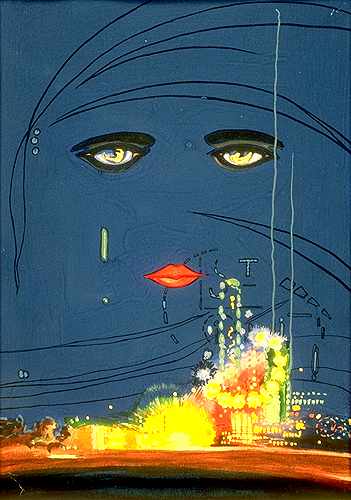So we beat on…
 The last line of The Great Gatsby is one of the most famous lines in American Literature:
The last line of The Great Gatsby is one of the most famous lines in American Literature:
So we beat on, boats against the current, borne ceaselessly into the past.
So you want to read The Great Gatsby?
-Free copies (to keep!) are available at Patrick Henry Villiage Library, the European Regional Library, or the Deutsch Amerikanisches Institute. Visit any one of these libraries and ask at the desk.
-Check out The Great Gatsby at Patrick Henry Villiage Library, the European Regional Library, or the Deutsch Amerikanisches Institute.
– For ID card holders we have The Great Gatsby as a downloadable audiobook. Ask a librarian for help.
-For immediate gratification, the full e-text is available free and online here: The Great Gatsby
The Art of The Great Gatsby
Not only is The Great Gatsby known as the Great American Novel- but it’s mysterious cover art is also regarded as a one of the most famous in American literature.
While Fitzgerald was still working on the novel, little-known artist Francis Cugat was commissioned to create the cover art. Not much is known about Cugat, and in fact, the cover art for The Great Gatsby is thought to be the only cover art he ever produced.
Cugat’s painting is was created in the popular Art Deco style, which itself was a decorative style that became synonymous with the roaring 20’s . A pair of eyes and lips float over the lights of a amusement park on a striking blue background. A single green tear falls from the right eye. The irises of the eyes are reclining nudes painted in the ethereal gouache method.
When Fitzgerald saw the finished product, he so admired it that he told his publishers that he had written it “into” the book.
This remark by Fitzgerald have led many to believe that the eyes are similar to the yellow spectacles of Dr. T. J. Eckleburg found in the faded billboard near George Wilson’s auto-repair shop.
From The Great Gatsby: “…Blue and gigantic — their retinas are one yard high. They look out of no face, but, instead, from a pair of enormous yellow spectacles which pass over a non-existent nose.”
Another interpretation is that the floating face is that of Jay Gatsby’s love interest, Daisy Buchanan. In the novel, Daisy is described as the “girl whose disembodied face floated along the dark cornices and blinding signs.”
Visit Heidelberg’s Patrick Henry Villiage Library, the European Regional Library, or the Deutsch Amerikanisches Institutefor more information on F. Scott Fitzgerald, The Great Gatsby, Francis Cugat, Art Deco, and the Roaring 20’s


